Nek Chand Saini (नेक चंद सैनी)is an Indian self-taught artist, famous for building the Rock Garden of Chandigarh, an eighteen acre sculpture garden in the city of Chandigarh, India.[1]
He hailed from Shakargarh region (now in Pakistan) of district Gurdaspur. His family moved to Chandigarh in 1947 during the Partition. At the time, the city was being redesigned as a modern utopia by the Swiss/French architect Le Corbusier. It was to be the first planned city in India, and Chand found work there as a roads inspector for the Public Works Department in 1951. He was awarded the Padma Shri by Government of India in 1984.
The Rock Garden
In his spare time, Chand began collecting materials from demolition sites around the city. He recycled these materials into his own vision of the divine kingdom of Sukrani, choosing a gorge in a forest near Sukhna Lake for his work. The gorge had been designated as a land conservancy, a forest buffer established in 1902 that nothing could be built on. Chand’s work was illegal, but he was able to hide it for eighteen years before it was discovered by the authorities in 1975. By this time, it had grown into a 12-acre (49,000 m2) complex of interlinked courtyards, each filled with hundreds of pottery-covered concrete sculptures of dancers, musicians, and animals.
His work was in serious danger of being demolished, but he was able to get public opinion on his side, and in 1976 the park was inaugurated as a public space. Nek Chand was given a salary, a title ("Sub-Divisional Engineer, Rock Garden"), and a workforce of 50 laborers so that he could concentrate full-time on his work. It even appeared on an Indian stamp in 1983. The Rock Garden is still made out of recycled materials; and with the government’s help, Chand was able to set up collection centers around the city for waste, especially rags and broken ceramics.
When Chand left the country on a lecture tour in 1996, the city withdrew its funding, and vandals attacked the park. The Rock Garden Society took over the administration and upkeep of this unique visionary environment. The garden is visited by over five thousand people daily, with a total of more than twelve million visitors since its inception
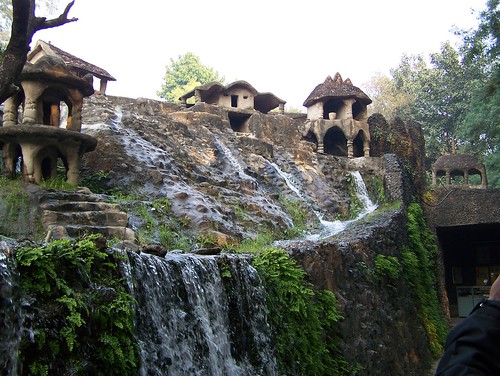
Nek Chand ROCK GARDEN – A mosaic fantasy waterfall – the black samurai

Nek Chand Garden Mosaic Sculpture fountain chdigarh, india – savagecorp
India’s Vast Trash Garden a Monument to Recycling
Pallava Bagla
in Chandigarh, Punjab, India
for National Geographic News
October 7, 2002
A glorious testament to the artistic and intrinsic value of trash stands in the middle of the northern Indian city of Chandigarh, the capital of Punjab and Haryana, India’s storied northwestern state on the border of Pakistan.
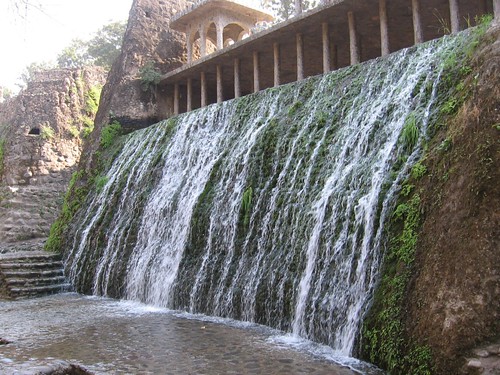
Rock Garden in Chandigarh on Flickr – briandubois
Called the “Rock Garden,” this sprawling amusement “kingdom” has been made completely from waste materials.
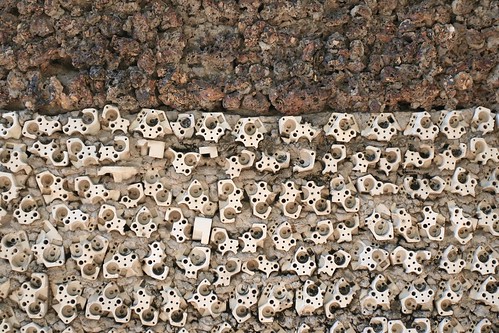
Nek Chand’s Junkwall detail on Flickr – diametrik
“Built of industrial waste and thrown-away items, the Rock Garden in the city of Chandigarh is perhaps the world’s most poignant and salient statement of the possibility of finding beauty in the unexpected and accidental.” Carl Lindquist – Nek Chand’s Rock Garden at Chandigarh, India
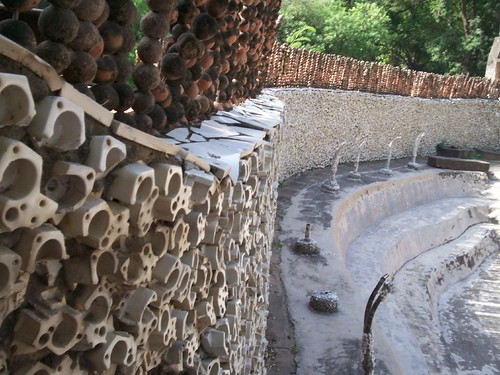
Nek Chand Rock Garden Outsider Art Wall of Electricity on Flickr – Uri Zer aviV
Created by celebrated artist Nek Chand, the garden highlights the value of materials many people consider trash.
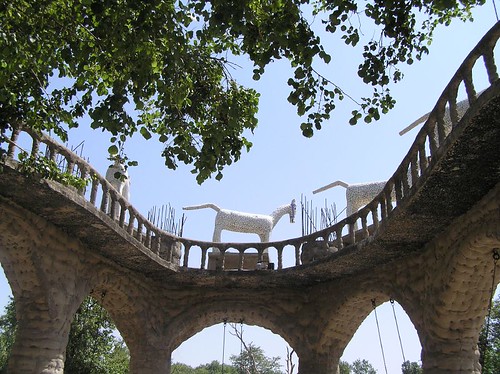
Nek Chand Rock Garden Recycled materials – ska ska202
For Chand, the Rock Garden is an expression of his hope for humanity and an idea that came to him four decades ago. “It all started out of personal curiosity,” said Chand, emphasizing that while others looked at trash as a problem that needed to be “hidden away,” he saw it as something that could be creatively transformed into art.
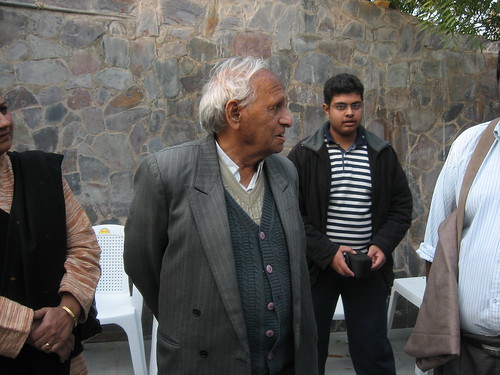
Mosaic Artist Nek Chand – Recycling Genius, Outsider Art - rougetete
Nek Chand started building his trash garden in the 1950s with urban and industrial waste, using everything he could lay his hands on, including stones and boulders to represent humans and animals. Pallava Bagla – India’s Vast Trash Garden a Monument to Recycling
Who is Nek Chand?
Nek Chand, a humble transport official in the north Indian city of Chandigarh, began to clear a little patch of jungle to make himself a small garden area.
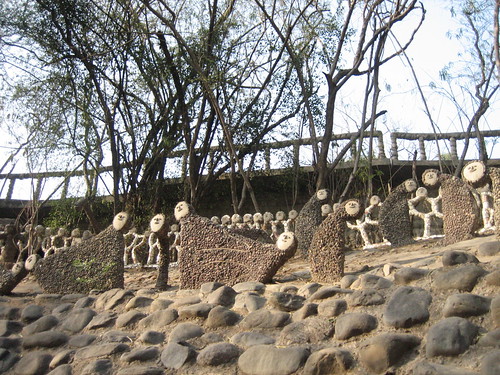
Nek Chand Rock Garden Pebble, Rock people Chandigarh, India – morleyroarly
He set stones around the little clearing and before long had sculpted a few figures

Nek Chand’s mosaic material stash ceramic tile broken crockery china- ToreaJade
recycled from materials he found at hand.
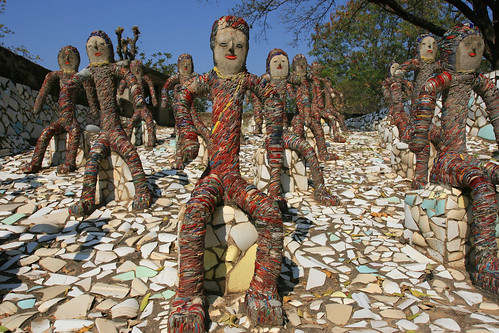
Nek Chand Rock Garden Mosaic Sculpture Bangle dudes – Carol Mitchell
Gradually Nek Chand’s creation developed and grew;
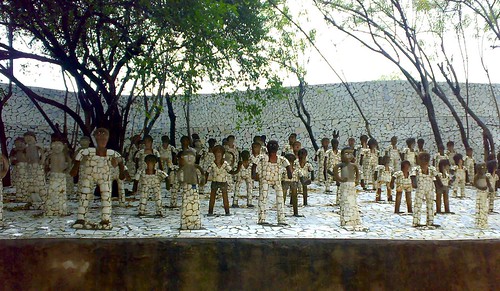
lil ppl rock garden ceramic tile mosaic art NeK Chand on Flickr – krazykrayons
before long it covered several acres

Figurenpark im Nek Chand Rock Garden von Chandigarh on Flickr – Uli Franke
and comprised of hundreds of sculptures
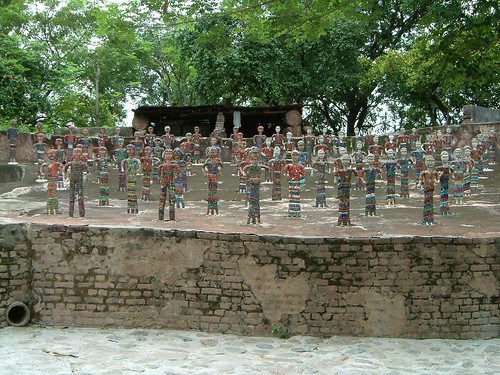
Bunte Figuren im Nek Chand Rock Garden von Chandigarh on Flickr – Uli Franke

Neck Chand monkey pebble art sculpture in rock garden on Flickr – baignid
set in a series of interlinking courtyards.
After his normal working day Chand worked at night, in total secrecy for fear of being discovered by the authorities.
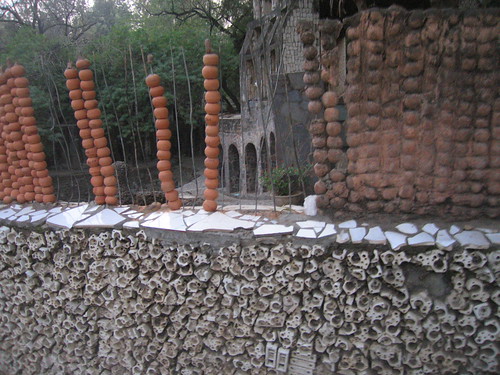
Recycled Wall Art ceramic tile, motors, sockets, ceramic pots – Ajay in India Tallam
When they did discover Chand’s garden, local government officials were thrown into turmoil. The creation was completely illegal – a development in a forbidden area which by rights should be demolished.
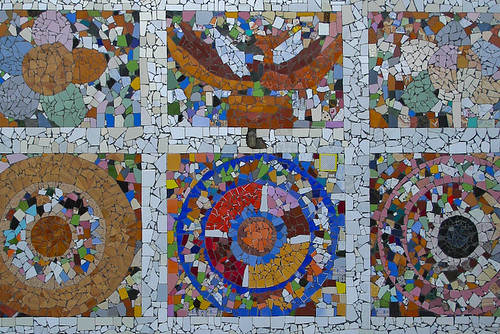
Nek Chand Picassiette Ceramic Tile Mosaic Art Garden – Angad
The outcome, however, was the enlightened decision to give Nek Chand a salary so that he could concentrate full-time on his work, plus a workforce of fifty labourers.
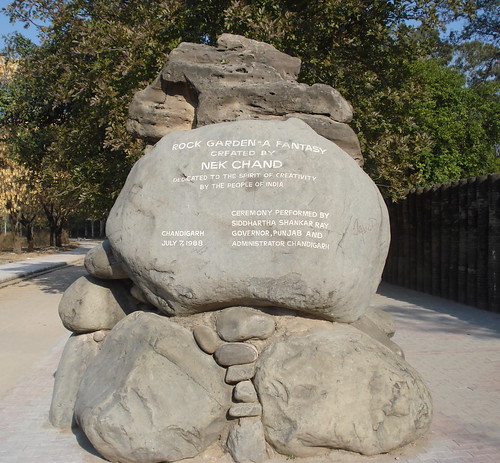
Nek Chand Rock Garden A Fantasy Monument Chandigarh, India – raksh
Nek Chand’s great work received immediate recognition and was inaugurated as The Rock Garden of Chandigarh.
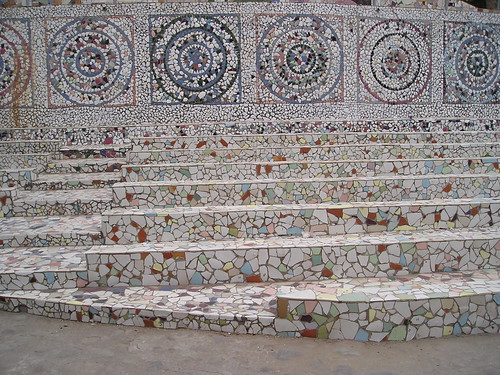
Nek Chand Mosaic ceramic tile picassiette steps on Flickr – travellingjohnny
Now over twenty five acres of several thousand sculptures set in large mosaic courtyards
linked by walled paths and deep gorges,
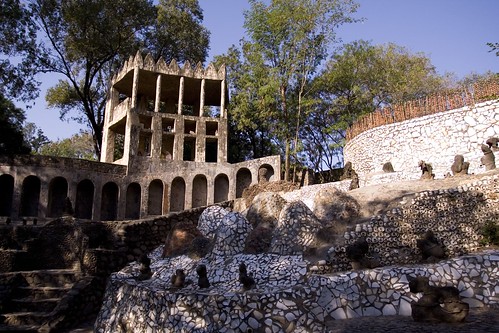
Nek Chand Rock Garden chandigarh india cathedral on Flickr – diametrik
Nek Chand’s creation also combines huge buildings
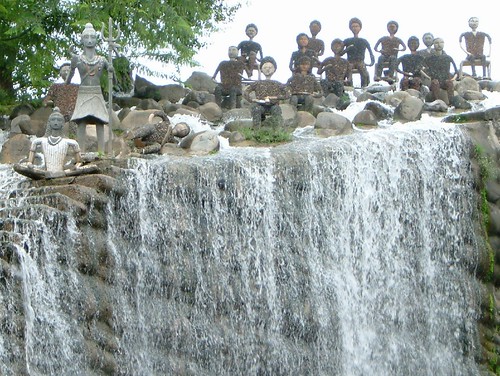
Figuren über Wasserfall im Rock Garden von Chandigarh on Flickr – Uli Franke
with a series of interlinking waterfalls.
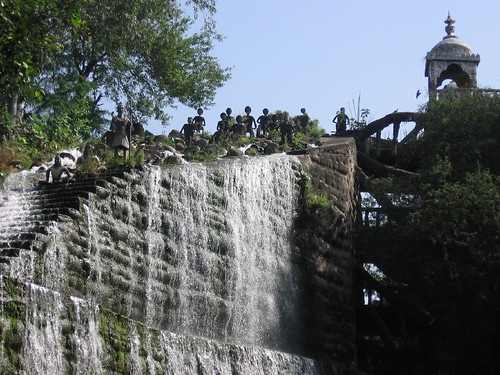
Nek Chand’s Sculptural Army above waterfall on Flickr – Uri Zer aviV
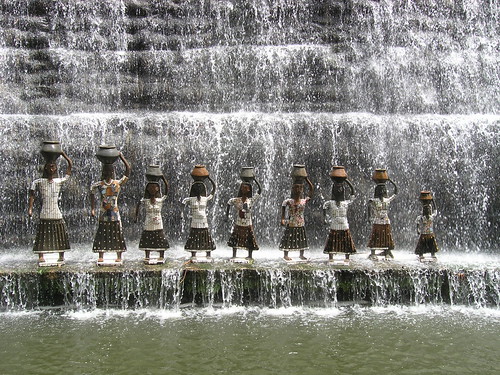
The Nek Chand Rock mosaic art people fountain sculpture – Matthew Winterburn
The Rock Garden is now acknowledged as one of the modern wonders of the world. Over 5000 visitors each day, some 12 million people so far, walk around this vast creation – the greatest artistic achievement seen in India since the Taj Mahal. Nek Chand Foundation
Where is Chandigarh?
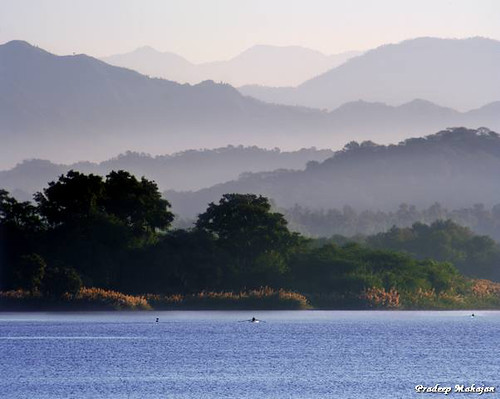
Lower Shivalik Mountains on Sukhna Lake on Flickr – Pradeep
Chandigarh is located near the foothills of the Shivalik range of the Himalayas in Northwest India.
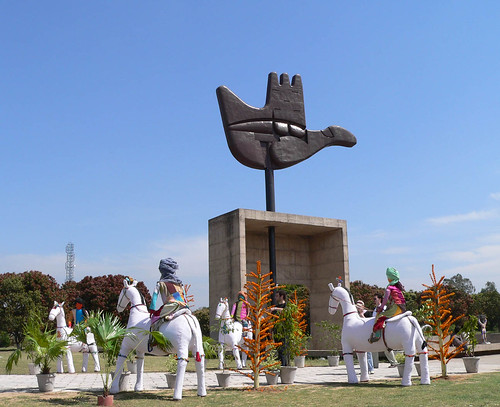
Le Courbusior Sculpture Open Hand official emblem of city of Chandigarh – Koshyk
Chandigarh, also called City Beautiful, is a city in India that serves as the capital of two states, Punjab and Haryana, and is a union territory of India.
He hailed from Shakargarh region (now in Pakistan) of district Gurdaspur. His family moved to Chandigarh in 1947 during the Partition. At the time, the city was being redesigned as a modern utopia by the Swiss/French architect Le Corbusier. It was to be the first planned city in India, and Chand found work there as a roads inspector for the Public Works Department in 1951. He was awarded the Padma Shri by Government of India in 1984.
The Rock Garden
In his spare time, Chand began collecting materials from demolition sites around the city. He recycled these materials into his own vision of the divine kingdom of Sukrani, choosing a gorge in a forest near Sukhna Lake for his work. The gorge had been designated as a land conservancy, a forest buffer established in 1902 that nothing could be built on. Chand’s work was illegal, but he was able to hide it for eighteen years before it was discovered by the authorities in 1975. By this time, it had grown into a 12-acre (49,000 m2) complex of interlinked courtyards, each filled with hundreds of pottery-covered concrete sculptures of dancers, musicians, and animals.
His work was in serious danger of being demolished, but he was able to get public opinion on his side, and in 1976 the park was inaugurated as a public space. Nek Chand was given a salary, a title ("Sub-Divisional Engineer, Rock Garden"), and a workforce of 50 laborers so that he could concentrate full-time on his work. It even appeared on an Indian stamp in 1983. The Rock Garden is still made out of recycled materials; and with the government’s help, Chand was able to set up collection centers around the city for waste, especially rags and broken ceramics.
When Chand left the country on a lecture tour in 1996, the city withdrew its funding, and vandals attacked the park. The Rock Garden Society took over the administration and upkeep of this unique visionary environment. The garden is visited by over five thousand people daily, with a total of more than twelve million visitors since its inception
One day 36 years ago, Nek Chand, a humble transport official in the north Indian city of Chandigarh, began to clear a little patch of jungle to make himself a small garden area. He set stones around the little clearing and before long had sculpted a few figures recycled from materials he found at hand. Gradually Nek Chand's creation developed and grew; before long it covered several acres and comprised of hundreds of sculptures set in a series of interlinking courtyards.
After his normal working day Chand worked at night, in total secrecy for fear of being discovered by the authorities.When they did discover Chand's garden, local government officials were thrown into turmoil. The creation was completely illegal - a development in a forbidden area which by rights should be demolished. The outcome, however, was the enlightened decision to give Nek Chand a salary so that he could concentrate full-time on his work, plus a workforce of fifty labourers. Nek Chand's great work received immediate recognition and was inaugurated as The Rock Garden of Chandigarh.
Now over twenty five acres of several thousand sculptures set in large mosaic courtyards linked by walled paths and deep gorges, Nek Chand's creation also combines huge buildings with a series of interlinking waterfalls. The Rock Garden is now acknowledged as one of the modern wonders of the world. Over 5000 visitors each day, some 12 million people so far, walk around this vast creation - the greatest artistic achievement seen in India since the Taj Mahal.

Nek Chand ROCK GARDEN – A mosaic fantasy waterfall – the black samurai

Nek Chand Garden Mosaic Sculpture fountain chdigarh, india – savagecorp
India’s Vast Trash Garden a Monument to Recycling
Pallava Bagla
in Chandigarh, Punjab, India
for National Geographic News
October 7, 2002
A glorious testament to the artistic and intrinsic value of trash stands in the middle of the northern Indian city of Chandigarh, the capital of Punjab and Haryana, India’s storied northwestern state on the border of Pakistan.

Rock Garden in Chandigarh on Flickr – briandubois
Called the “Rock Garden,” this sprawling amusement “kingdom” has been made completely from waste materials.

Nek Chand’s Junkwall detail on Flickr – diametrik
“Built of industrial waste and thrown-away items, the Rock Garden in the city of Chandigarh is perhaps the world’s most poignant and salient statement of the possibility of finding beauty in the unexpected and accidental.” Carl Lindquist – Nek Chand’s Rock Garden at Chandigarh, India

Nek Chand Rock Garden Outsider Art Wall of Electricity on Flickr – Uri Zer aviV
Created by celebrated artist Nek Chand, the garden highlights the value of materials many people consider trash.

Nek Chand Rock Garden Recycled materials – ska ska202
For Chand, the Rock Garden is an expression of his hope for humanity and an idea that came to him four decades ago. “It all started out of personal curiosity,” said Chand, emphasizing that while others looked at trash as a problem that needed to be “hidden away,” he saw it as something that could be creatively transformed into art.

Mosaic Artist Nek Chand – Recycling Genius, Outsider Art - rougetete
Nek Chand started building his trash garden in the 1950s with urban and industrial waste, using everything he could lay his hands on, including stones and boulders to represent humans and animals. Pallava Bagla – India’s Vast Trash Garden a Monument to Recycling
Who is Nek Chand?
Nek Chand, a humble transport official in the north Indian city of Chandigarh, began to clear a little patch of jungle to make himself a small garden area.
ROCK GARDEN Mosaic Pebble man – the black samurai

Nek Chand Rock Garden Pebble, Rock people Chandigarh, India – morleyroarly
He set stones around the little clearing and before long had sculpted a few figures

Nek Chand’s mosaic material stash ceramic tile broken crockery china- ToreaJade
recycled from materials he found at hand.

Nek Chand Rock Garden Mosaic Sculpture Bangle dudes – Carol Mitchell
Gradually Nek Chand’s creation developed and grew;

lil ppl rock garden ceramic tile mosaic art NeK Chand on Flickr – krazykrayons
before long it covered several acres

Figurenpark im Nek Chand Rock Garden von Chandigarh on Flickr – Uli Franke
and comprised of hundreds of sculptures

Bunte Figuren im Nek Chand Rock Garden von Chandigarh on Flickr – Uli Franke

Neck Chand monkey pebble art sculpture in rock garden on Flickr – baignid
set in a series of interlinking courtyards.
After his normal working day Chand worked at night, in total secrecy for fear of being discovered by the authorities.

Recycled Wall Art ceramic tile, motors, sockets, ceramic pots – Ajay in India Tallam
When they did discover Chand’s garden, local government officials were thrown into turmoil. The creation was completely illegal – a development in a forbidden area which by rights should be demolished.

Nek Chand Picassiette Ceramic Tile Mosaic Art Garden – Angad
The outcome, however, was the enlightened decision to give Nek Chand a salary so that he could concentrate full-time on his work, plus a workforce of fifty labourers.

Nek Chand Rock Garden A Fantasy Monument Chandigarh, India – raksh
Nek Chand’s great work received immediate recognition and was inaugurated as The Rock Garden of Chandigarh.

Nek Chand Mosaic ceramic tile picassiette steps on Flickr – travellingjohnny
Now over twenty five acres of several thousand sculptures set in large mosaic courtyards
linked by walled paths and deep gorges,

Nek Chand Rock Garden chandigarh india cathedral on Flickr – diametrik
Nek Chand’s creation also combines huge buildings

Figuren über Wasserfall im Rock Garden von Chandigarh on Flickr – Uli Franke
with a series of interlinking waterfalls.

Nek Chand’s Sculptural Army above waterfall on Flickr – Uri Zer aviV

The Nek Chand Rock mosaic art people fountain sculpture – Matthew Winterburn
The Rock Garden is now acknowledged as one of the modern wonders of the world. Over 5000 visitors each day, some 12 million people so far, walk around this vast creation – the greatest artistic achievement seen in India since the Taj Mahal. Nek Chand Foundation
Where is Chandigarh?

Lower Shivalik Mountains on Sukhna Lake on Flickr – Pradeep
Chandigarh is located near the foothills of the Shivalik range of the Himalayas in Northwest India.

Le Courbusior Sculpture Open Hand official emblem of city of Chandigarh – Koshyk
Chandigarh, also called City Beautiful, is a city in India that serves as the capital of two states, Punjab and Haryana, and is a union territory of India.

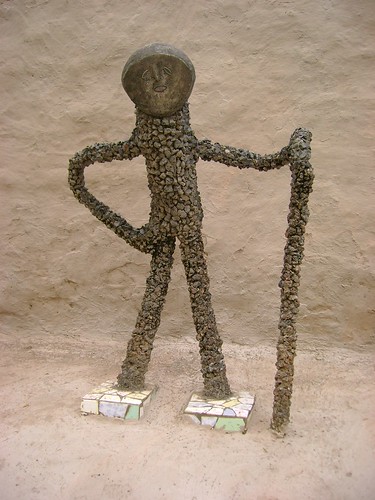
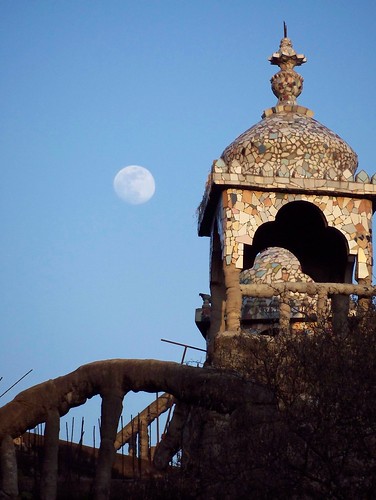
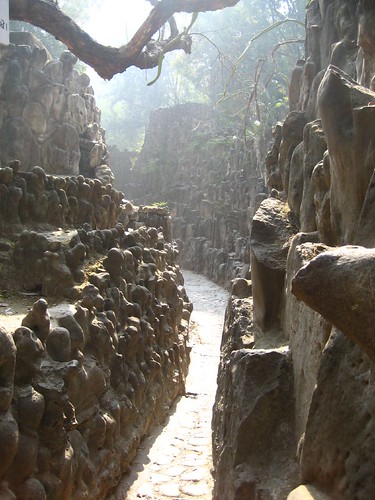

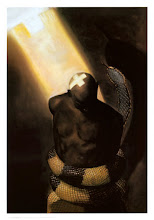
0 comments:
Post a Comment